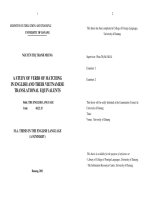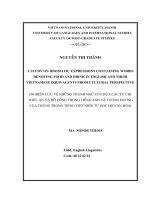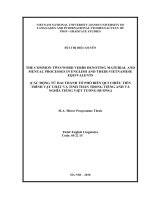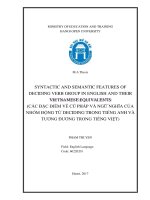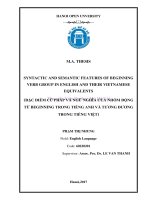METONYMY IN ENGLISH AND IN VIETNAMESE
Bạn đang xem bản rút gọn của tài liệu. Xem và tải ngay bản đầy đủ của tài liệu tại đây (110.83 KB, 15 trang )
VIETNAM NATIONAL UNIVERSITY, HANOI
UNIVERSITY OF LANGUAGES AND INTERNATIONAL STUDIES
DEPARTMENT OF POST-GRADUATE STUDIES
METONYMY IN ENGLISH AND IN VIETNAMESE
SUBJECT: SEMANTICS
(END-TERM ASSIGNMENT)
Student:
Course:
Supervisor:
Deadline:
Bùi Thị Ánh Ngọc
M.A.18
Hà Cẩm Tâm, Ph.D
June 28th, 2010
Hanoi, June 2010
1
TABLE OF CONTENTS
PART 1: RATIONALE------------------------------------------------------3
PART 2: DEVELOPMENT------------------------------------------------4
2.1. Transference of meaning-------------------------------------------------4
2.2. Metonymy in English----------------------------------------------------4
2.3. Metonymy in Vietnamese------------------------------------------------8
2.4. Comparison between metonymy in English and in Vietnamese
2.4.1. Similarities------------------------------------------------------10
2.4.2. Differences------------------------------------------------------12
2.5. Implications for teaching vocabulary for Vietnamese learners---12
PART 3: CONCLUSION--------------------------------------------------14
REFERENCES
2
PART 1: RATIONALE
There is an intimate connection between each language and its culture.
A language cannot be studied separately from the cultural traditions of its
speakers. The origin of language is still argued. When time passes by,
language has been enriched and changed. Semantic change is a change in
one of the meanings of a word. Every word has a variety of senses and
connotations which can be added, removed or altered. The transference of
meaning results from both linguistic and extra linguistic causes. In the
process of cognition of the world and in the process of using language
effectively and creatively, human beings try to use one linguistic element to
refer to different things. Beside, when the new or the professional concepts
come into life, language needs to be changed accordingly.
There are various ways of transferring a word meaning into the new
ones. Due to time limitation, this study is only focused on Metonymy.
Metonymy is an important way of expressing ideas. It is the substitution of
one word for another with which it is associated. A metonymic description
of a subject is an essential part of any language; thus metonymic thought
can be considered as an element of the cultural identity of a person.
When learning English, some students feel very confused and spend a
lot of time finding the Vietnamese equivalents for the expression of English
like:
The ham sandwich has asked for the bill.
The main reason rooted from their unawareness of the term metonymy
and the similarities as well as differences between metonymy in English
and in Vietnamese.
Therefore, metonymy is chosen as the topic of my study in the hope
that the researcher will get thorough and sound understanding of the field
that it is envisioned.
3
PART 2: DEVELOPMENT
2.1. Transference of meaning
The transference of meaning, as defined by Nguyen Hoa (2001:64),
refers to a situation when one object is named and understood in terms of
another. In other words, one word can extend its meaning or narrow its
meaning to refer to another object.
There are some types of transference of meaning, such as metaphor,
metonymy, hyperbole, irony, etc. In the next parts, one among those types
called Metonymy will be discussed in detail.
2.2. Metonymy in English
2.2.1. Definition
According to Nguyen Hoa, metonymy is the transference of meaning
from one object to another based on contiguity of notions, i.e. instead of the
name of one object or notion we use the name of another because these
objects are associated and closely related.
Metonymy, therefore, is the substitution of one word for another with
which it is associated. In other words, instead of the name of one objector
notion, we use the name of another because these objects are associated and
closely related.
For example:
The White House announced a press conference for four o’clock Sunday.
The White House means the people in the White House.
Moreover, the metonym is a kind of “local” word perceived in a
system of beliefs that is available only to a sub-section of the community.
For example:
The white jersey was very nice.
2.2.2. Basis of the transference
4
The transference is based on material, causal or conceptual relation.
2.2.2.1. Object – for – possessor
Example:
The Crown in fact has little power.
The “Crown” is used to indicate the Monarchy.
2.2.2.2. Part – for – whole
Example:
We don’t employ long hairs.
“Long hairs” mean girls with long hairs.
2.2.2.3. Place – for – event
Example:
Pearl Harbor was a sad event in America’s history.
“Pearl Harbor” is a place-for-event metonymy: it refers to the battle at
Pearl Harbor in December 7th, 1941.
2.2.2.4. Place – for – institution
Example:
The Pentagon announced its new policy yesterday.
“Pentagon” is a metonymy: institution refers to persons in charge. It refers
to chiefs of staff at the Pentagon - the Unites States Department of Defense.
2.2.2.5. Thing – for – perception
Example:
There goes my knee. (The pain in my knee)
2.2.3. Cases of metonymy
2.2.3.1. Name of container instead of the thing contained
Examples:
The kettle is boiling. (1)
He drank the whole cup. (2)
5
It is obvious that the “kettle” cannot boil and the man cannot swallow
the “cup”. It is not the kettle but water in that kettle is boiling. Also, the
man drank some beer or water in the cup, not the cup itself. In other words,
the words “kettle” and “cup” in those examples are used to refer to other
things, which are contained in those kinds of containers.
2.2.3.2. Parts of human body as symbols
Sometimes, names of parts of human body are used to be the symbol
for characteristics of a kind of person.
Examples:
I was moved by his kind heart. (3)
John has a clever head. (4)
Metonymic sense
3
.
4
.
Kind heart
It’s a symbol of a kind person.
Clever head
It’s a symbol of an intelligent person.
2.2.3.3. The concrete instead of the abstract
Concrete is what we can see or feel, whereas abstract is something
existing in thought or an idea but not having a physical or practical
existence. It is not easy to express something abstract, so people tend to use
the concrete to visualize the abstract.
For example:
5
From
.
cradle to the a baby which can be the whole of a person's
grave
the - cradle: a small bed for A way of referring to
pushed gently from side life, from birth until
to side
death
- grave: a place in the
ground where a dead
6
person is buried
up Roll up a part of a piece To prepare to work or
6
Roll
.
your sleeves of clothing that covers fight
all or part of your arm
2.2.3.4. Materials instead of the things made of the materials
In many cases, the name of materials is taken to name their products.
Let’s take some examples:
“Put it on the plastic”, the bank officer said.
“Plastic” is a metonymy: the material, instead of the object made - the
credit card, is used.
He got Gold in the Winter Olympics.
“Gold” is a metonymy: the material, instead of the object made - the gold
medal, is used.
2.2.3.5. Name of the author instead of his works
Author and his works share a very close relation and his name can
normally not be separated from his works. Hence, the authors’ names are
transferred to denote their works. For example:
She likes to read Poe.
“Poe” is a metonymy: the works of Edgar Allan Poe.
He’s got a Picasso.
“Picasso” is a metonymy: it is a Picasso’s work.
2.2.3.6. Part for the whole
Example:
We live in the same roof.
“Roof” is the structure that covers or forms the top of a building. It means
the house/building.
He’s always running after the skirt.
7
“Skirt” is a piece of clothing for a woman or girl that hangs from the waist.
It is used as a metonymy to mean “the girl”.
2.2.3.7. Name of places and name of products made there
Example:
He used to smoke Havanas.
“Havana” is the capital of Cuba. It is used as a metonymy to denote “the
cigar”.
2.2.3.8. Others
Beside above cases, there are some more can be found in English
including: spatial relation (1), causal relation (2), functional relation (3) and
geographical relation (4). Illustrations are shown in the following table.
1
Word
the chair
Original use
Metonymic sense
the position of being in the person who hold the
charge of a meeting or a position of being in charge
committee
2
fear
fer
(danger)
of
in
English
3
4
a
meeting
or
a
committee
Old the bad feeling that you
have when you are in
pen
danger
an instrument used for to pen: to write something
holland
writing with ink
name of a country
linen
2.3. Metonymy in Vietnamese
In Vietnamese, there is a system of metonymic relations which can
help to transfer the meaning of many words. Some most common cases
from the theories of Diep Quang Ban (1999) and Dinh Trong Lac (1997)
are listed as follow.
2.3.1. Name of container instead of the thing contained
8
The relation between container and things contained is used with
almost of containers such as “Ăn ba bát” (eat up three bowls), uống vài
chén (drink some cups), etc.
The term “container” has more general sense like in the following
examples:
Cả hội trường đổ ra xem.
“Vì sao trái đất nặng ân tình
Nhắc mãi tên người Hồ Chí Minh.”
(Tố Hữu)
bát
chén
hội trường
trái đất
Original use
bowl
cup
hall
the Earth
Metonymic sense
bowl of rice/soup, etc.
cup of tea/wine, etc.
members in the hall
people on the Earth
2.3.2. The concrete instead of the abstract
In Vietnamese, especially in poems, we can find some cases using
working tools to refer the result of labor. For instance:
“Bàn tay ta làm nên tất cả
Có sức người sỏi đá cũng thành cơm.”
The result of an action which is normally visible sometimes used to
refer to that long lasting action:
“Mồ hôi mà đổ xuống đồng
Lúa mọc trùng trùng sáng cả đồi nương.”
With the use of the word “mồ hôi” (sweat), we can imagine how hard
farmers work in order to have a good crop.
2.3.3. Name of the author instead of his works
“(…) Người ta nói đọc Nguyễn Tuân phải đọc lúc nhàn rỗi là vì
thế…”
9
(Nguyễn Đăng Mạnh)
In this example, Nguyễn Tuân refers to Nguyễn Tuân’s works.
2.3.4. Part - for - whole and whole - for - part
Any object has its part which can be taken to substitute to the whole or
to convey extra meaning. For instance:
“Đầu xanh có tội tình gì
Má hồng đến q nửa thì chưa thơi.”
“Đầu xanh” – a part of human body is used to refer to a young
person. “Má hồng” indicates a girl or a young woman.
“Những mái nhà lụp xụp đứng chen lấn nhau trong cái ngõ nhỏ tồi
tàn.”
“Mái nhà” here (roofs) means houses.
In other cases, the whole is used to replace the part as in the following
example:
“Bao nhiêu năm đã qua, đầu đã muối tiêu mà hắn vẫn cịn cái tính
trăng hoa ấy.”
The word “đầu” (head) refers to “tóc” (hair).
2.3.5. Object - for - possessor
“Áo chàm đưa buổi phân ly
Cầm tay nhau biết nói gì hơm nay.”
(Tố Hữu)
“Áo chàm”, a kind of clothes of the minority in the North East of
Vietnam is used to substitute for people there.
2.4. Comparison between metonymy in English and in Vietnamese
2.4.1. Similarities
As it can be seen, English people and Vietnamese people utilize some
same relations as the means of metonymy, such as part – whole, container –
things contained, concrete – abstract, author’s name – his works, etc.
10
English
Vietnamese
We live in the same Chúng tôi sống chung
Part – whole
roof.
dưới một mái nhà.
Container – things He’s just eaten three Anh ấy vừa ăn 3 bát.
contained
Concrete – abstract
bowls.
He rolls up his sleeves Anh ta xắn tay áo lên
to
meet
the cho kịp thời hạn đã
deadline.
định.
Author’s name – his She used to read Sidney Trước
works
Sheldon
before thường
bed time.
đây,
đọc
cô
ấy
Sidney
Sheldon trước khi đi
ngủ
From those examples, we can realize that metonymy in both English
and Vietnamese share some common in the use of particular words.
“Head”, “hand” are usually used to substitute for “Person”; “bowl” refers
to things contained, etc.
2.4.2. Differences
First, to name a thing, Vietnamese people and English people use the
name of different things. For example:
In English:
He is always running after the skirt.
In Vietnamese:
Hắn ln chạy theo những bóng hồng/áo dài.
It can be explained that the image of woman in Western in general has
a close association with the image of a “skirt”, whereas not many
Vietnamese women wear skirts. Whenever people talk about Vietnamese
women, they often think of a traditional long dress.
Furthermore, some cases of metonymy which are popular in English are rarely used in
Vietnamese. For example:
Word
Glass
Metonymic sense in English
container
11
Vietnamese equivalent
cốc
Rubber
eraser
tẩy
This is because the concepts “cốc, tẩy” came to life and had a fixed
idea in Vietnamese people’s mind before the appearance of those objects
which are made of or from.
2.5. Implications for teaching vocabulary for Vietnamese learners
Metonymy is not just a figure of speech, but reflects an important part
of the way people conceptualize themselves, events and the everyday
world. Metonymy also helps structure various aspects of inference
generation in discourse, as well as people’s understanding and use of
contextual expression, indirect speech acts, common gestures, and
colloquial tautologies.
Therefore, in teaching English in general and in teaching vocabulary
in particular, teaching metonymy is essential. Learning metonymy will help
students enrich their vocabulary so as to make their communication
successful and effective.
Teachers should help students find the link between the word’s
original use and metonymic sense, i.e. provide them some relations which
can help students to understand metonymic sense without the help of their
teacher.
Moreover, one of the best ways to realize the matter and avoid any
mistakes in using language and translation is to make a comparison
between the two languages. A simple grid can be useful as follows:
Word
English
Original
Metonymic Word
Vietnamese
Original
Metonymic
use
use
sense
……
12
sense
As a result, students will have their own collection of vocabulary as
well as their metonymic senses.
Students need some more practice on metonymy so that teachers
should provide students with time in class. With a little time together,
students can show their friends what they have know about metonymy and
share with one another their collection. All students then also try to use
their vocabulary with some metonymic senses to make up a joke, for
example.
Moreover, teachers can ask students to create some situations which
are normally funny in form of a small role-play. This activity will bring a
lot of fun to the whole class as well as helps them to remember the
vocabulary and the metonymic senses in a meaningful way.
PART 3: CONCLUSION
This small study provides readers with a systematic and clear view on
metonymy in English and in Vietnamese. The most common cases of
metonymy have been presented and then compared to find out the
similarities as well as differences between the two languages. First, in both
English and Vietnamese, words are used creatively and metonymy is one of
the most popular means to transfer meanings of words. Second, metonymy
is both based on some similar relations, such as part-whole, concreteabstract, container-contained, etc. On the other hand, because each country,
13
each culture has their own way of thinking and conceptualizing things,
sometimes the same term in English and in Vietnamese is used to substitute
to different things. It can be also seen that English and Vietnamese people
have different habit of employing metonymic relations so that some
popular in this language are rarely used in the other.
Based on the theory, some pedagogical implications are drawn.
Teachers should help students find the link between the word’s original use
and metonymic sense. Besides, it is recommended that students had better
make a contrastive comparison between metonymy in English and in
Vietnamese through grids, tables, etc. Moreover, students need some more
practice on metonymy in the way of role plays assigned by the teacher.
Word count: 2,577
REFERENCE
ENGLISH
1. Nguyen Hoa (2001). An introduction to semantics. Hanoi: VNU Press
2. Jackson, A. (2000). Words, meaning and vocabulary. London and New
York: Cassell.
3. Lyons, J. (1995). Linguistic semantics. Cambridge: Cambridge
University Press.
4. McMahon, A.M.S. (1994). Understanding language change. Cambridge:
Cambridge University Press.
14
5. Yule, G. (1985). The study of language. Cambridge: Cambridge
University Press
VIETNAMESE
6. Diệp Quang Ban (1999). Ngữ pháp tiếng Việt. Hà Nội: Nhà xuất bản
Giáo dục.
7. Đinh Trọng Lạc (2004). 99 Phương tiện và biện pháp tu từ tiếng Việt. Hà
Nội: Nhà xuất bản Giáo dục.
8. Đinh Trọng Lạc (chủ biên) (1997). Phong cách học tiếng Việt. Hà Nội:
Nhà xuất bản Giáo dục.
9. Nguyễn Đăng Mạnh (2005). Nhà văn Việt Nam hiện đại, chân dung và
phong cách. Nhà xuất bản Trẻ.
15
